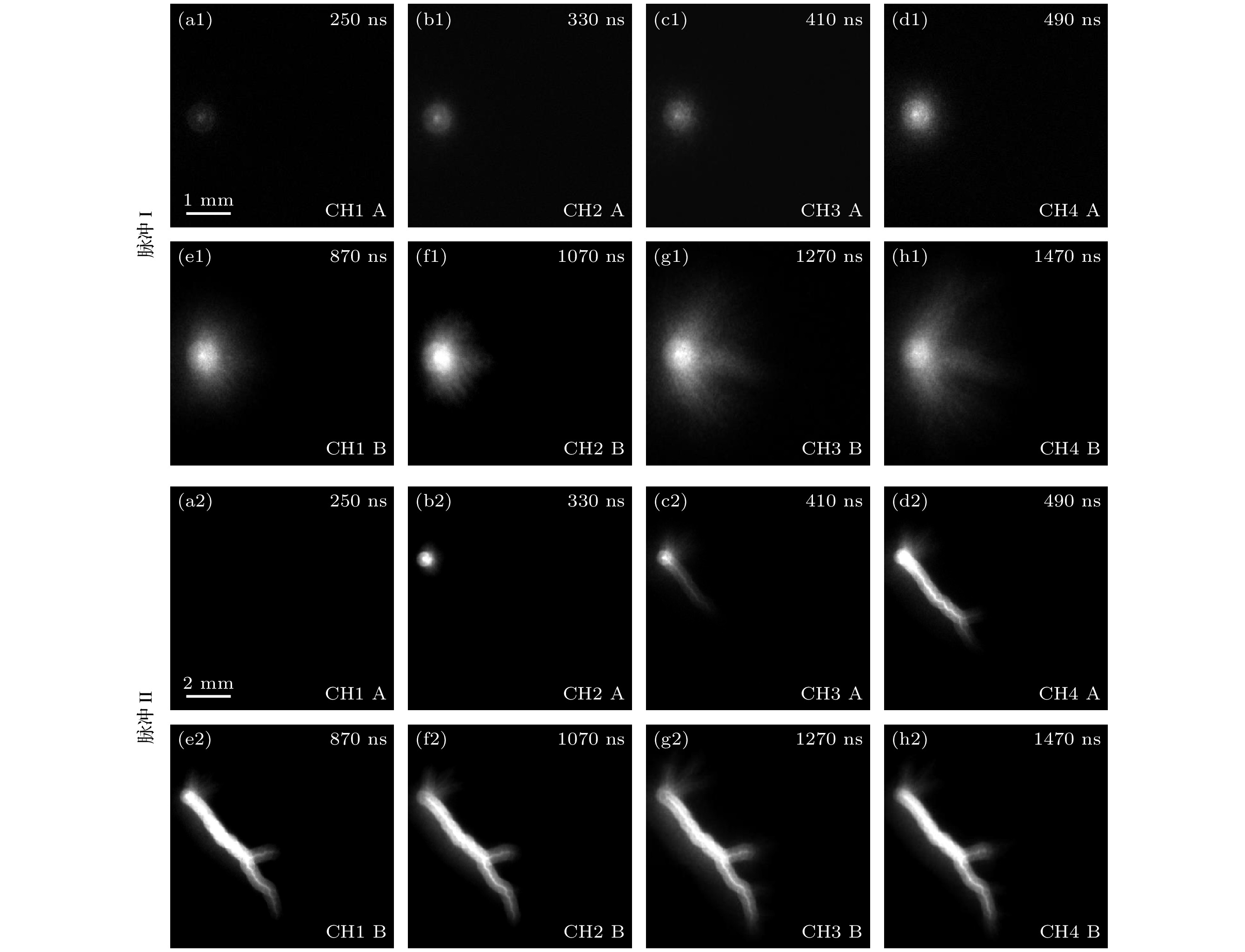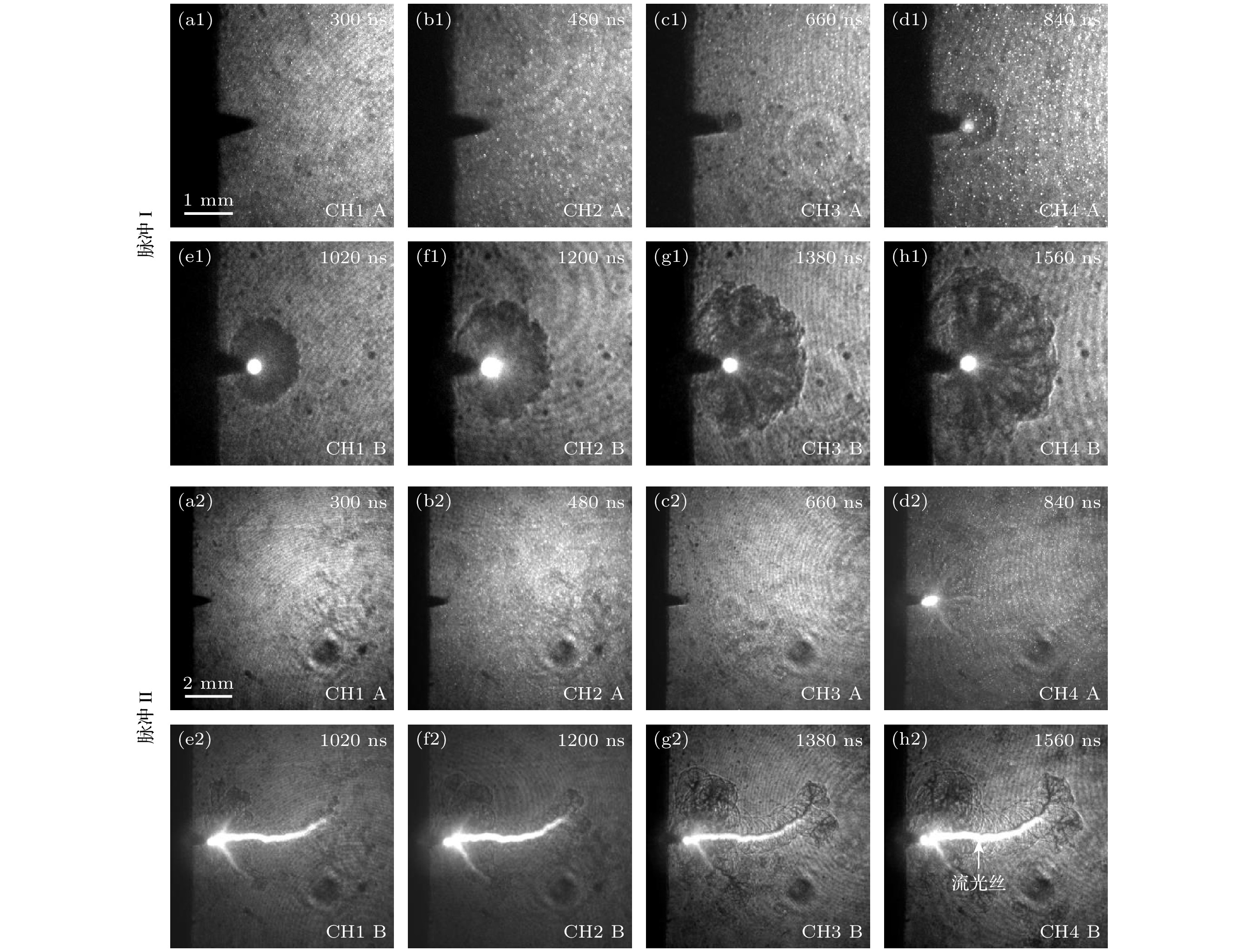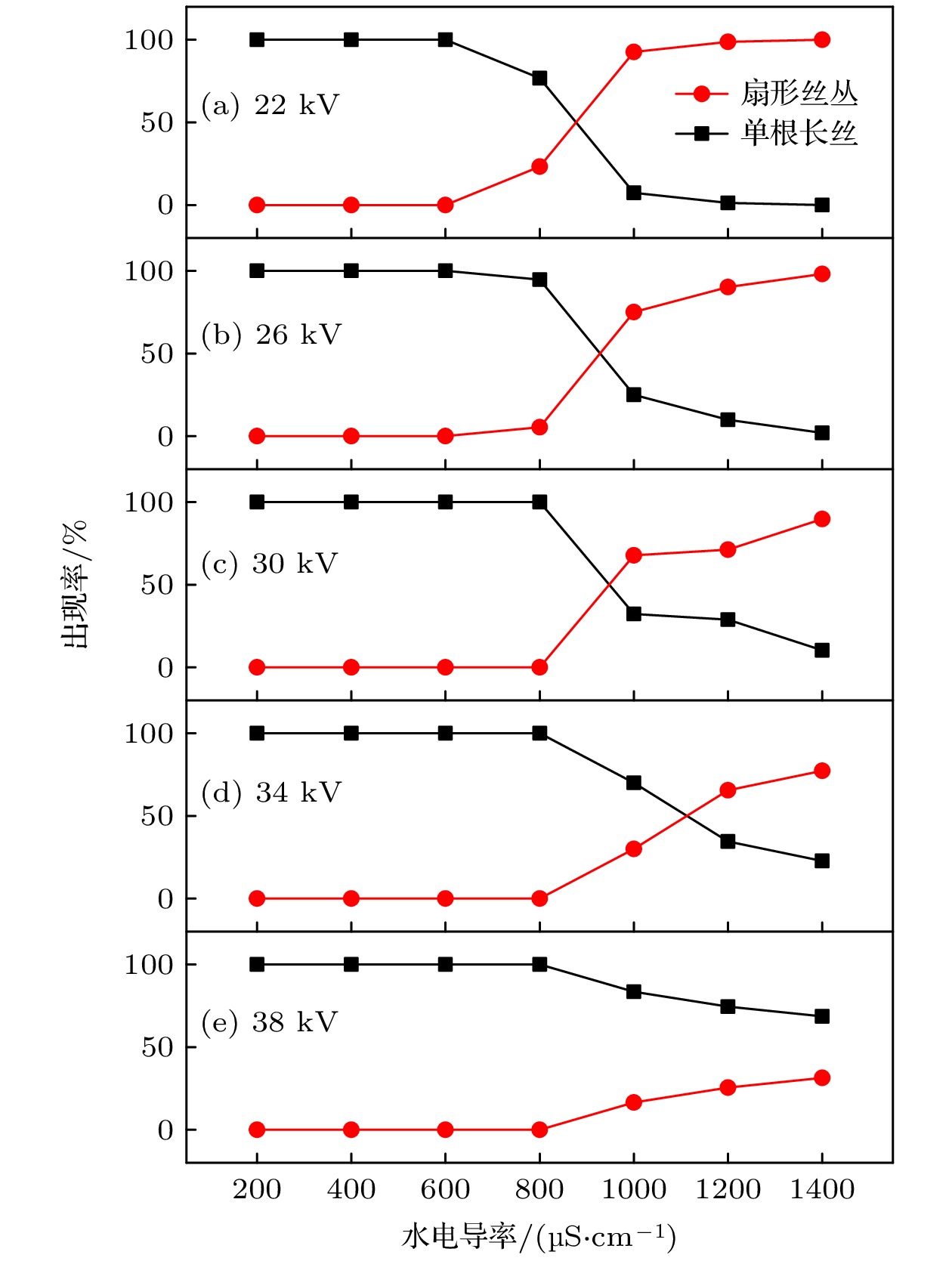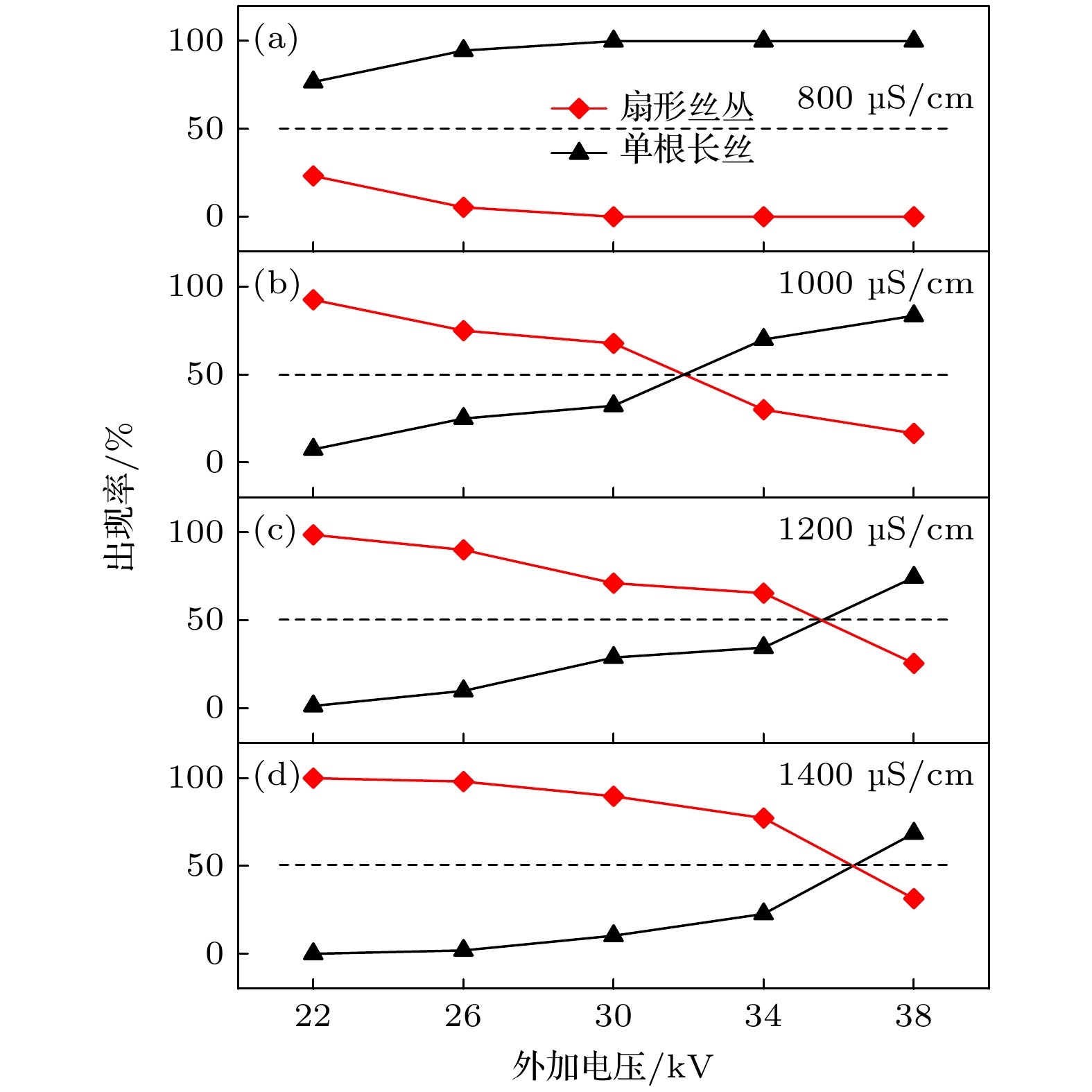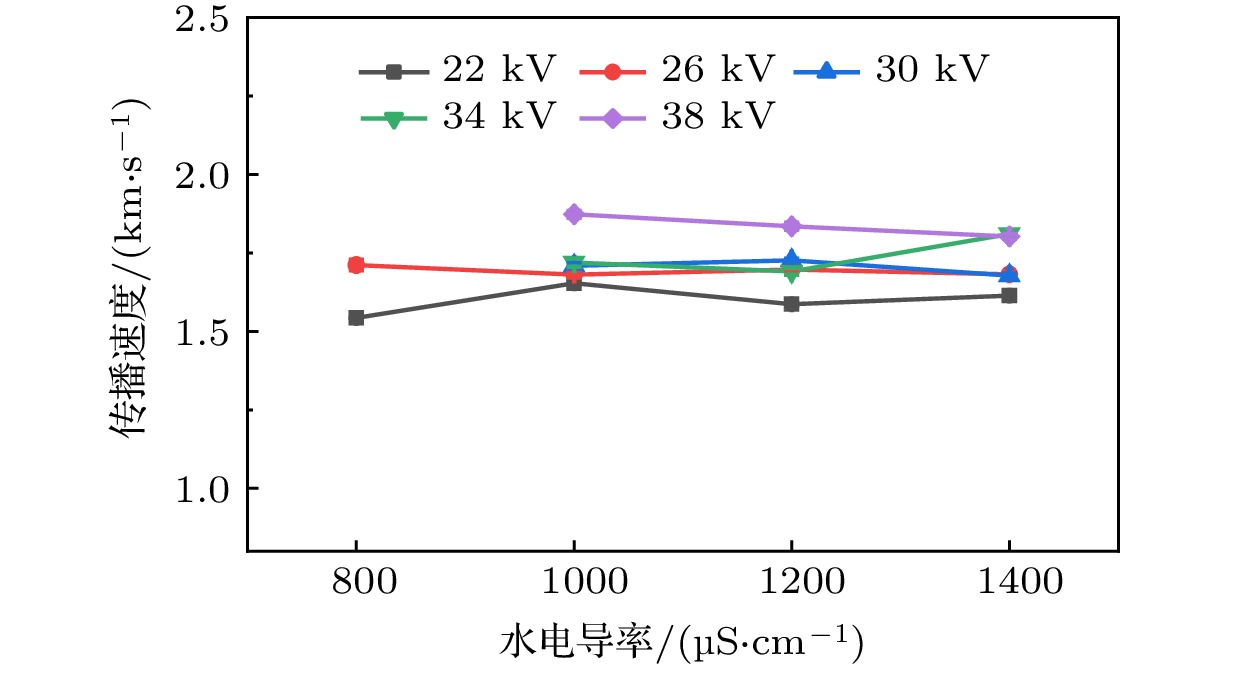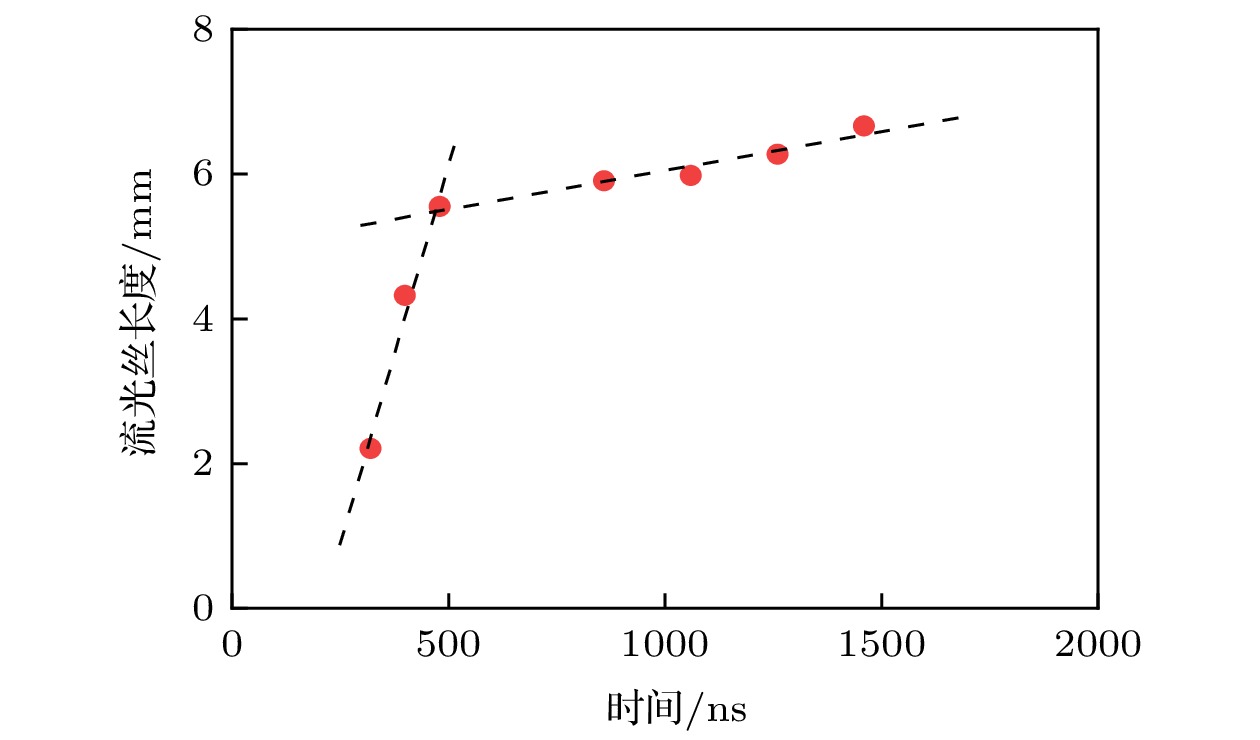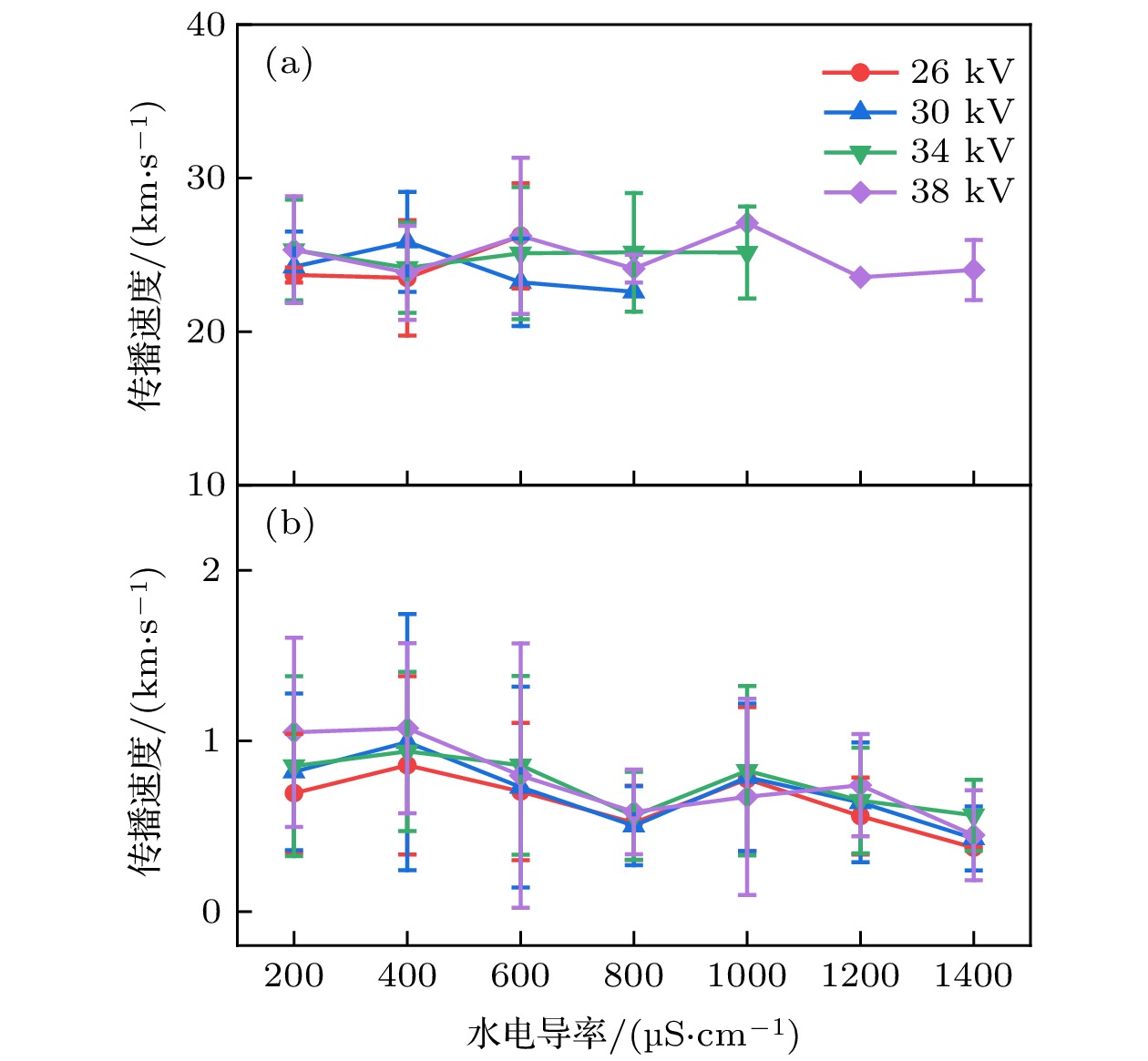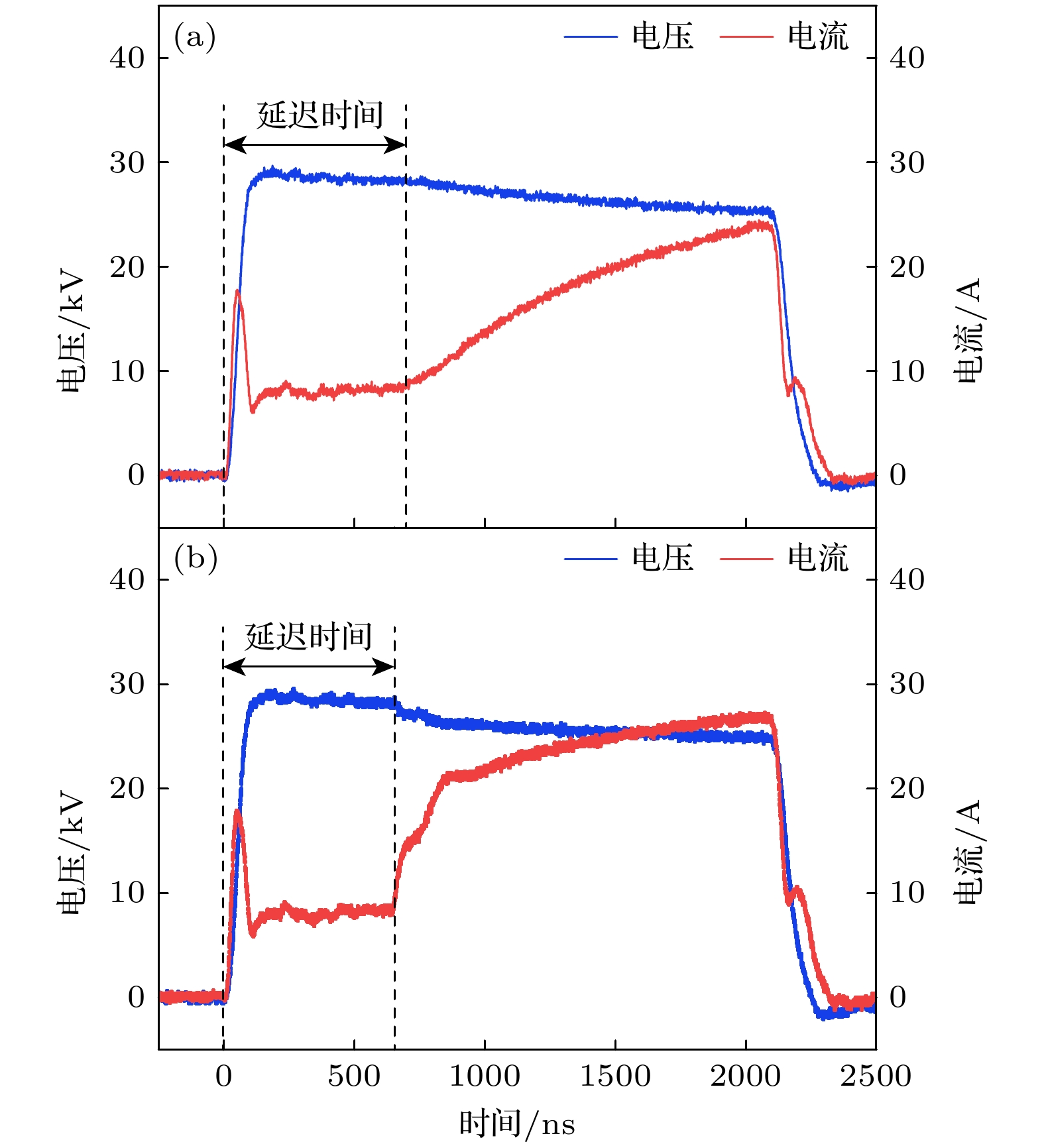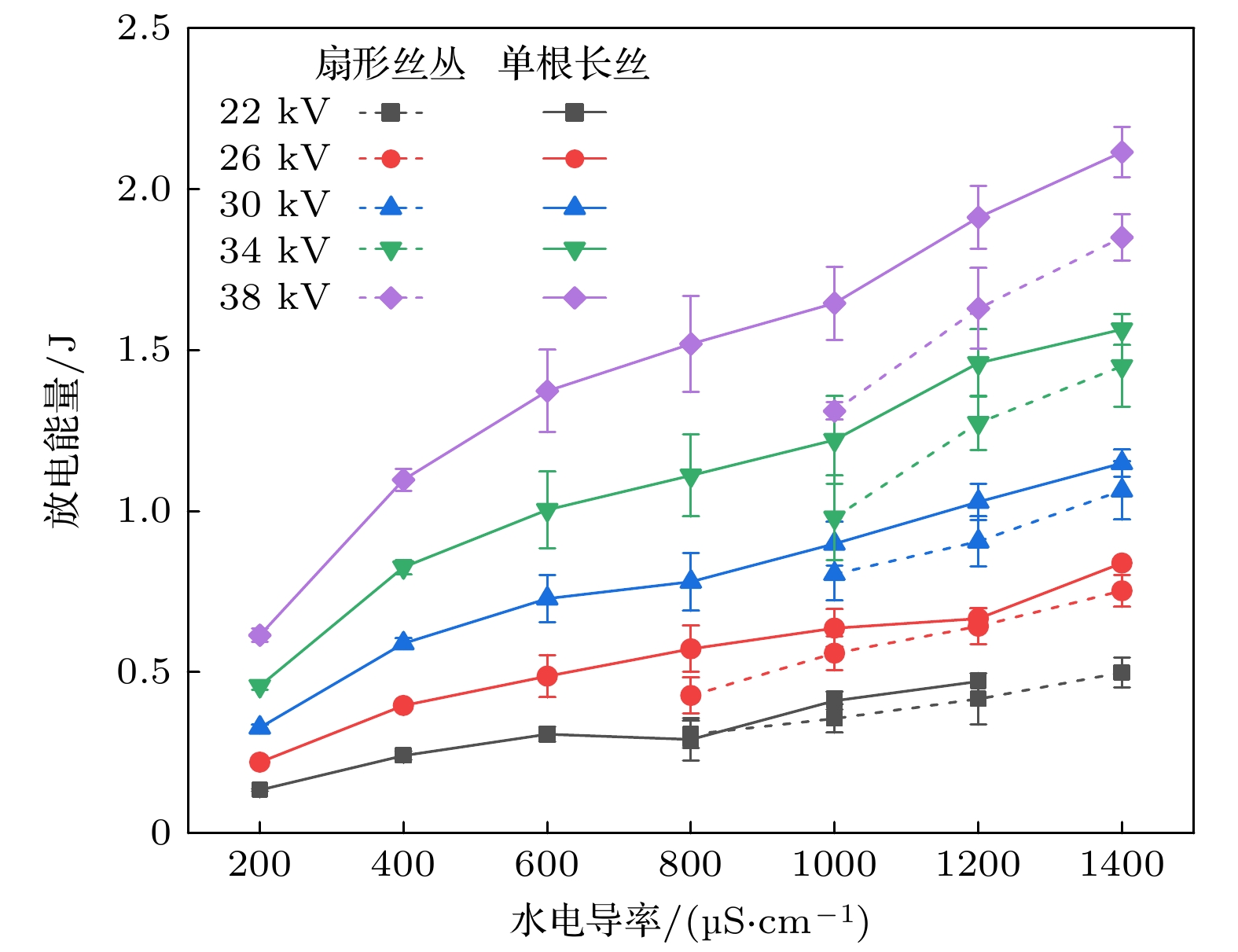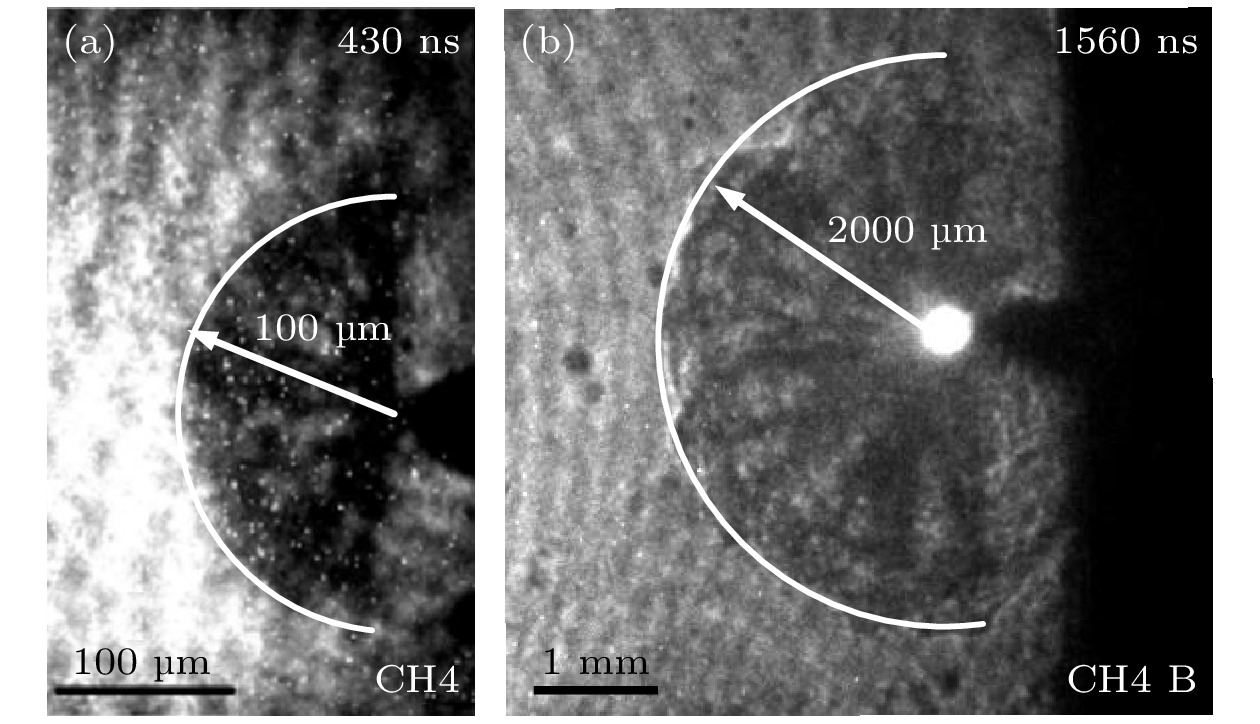-
水下流光放电在降解水中有机污染物、改良农作物种子等方面有良好的应用前景, 其放电形态对实际应用效果有重要影响. 本文利用四分幅超高速相机观测了不同水电导率、外加电压条件下水下微秒脉冲流光放电过程, 发现在高水电导率条件下存在两种不同的放电形态: 扇形丝丛和单根长丝. 在本文研究范围内水电导率800 µS/cm是两种形态出现率的分界点: 水电导率小于800 µS/cm时, 单根长丝形态的出现率为100%; 水电导率大于800 µS/cm时, 随着水电导率的增大, 单根长丝形态的出现率降低, 扇形丝丛形态的出现率增大; 水电导率大于1000 µS/cm后, 主导放电形态为扇形丝丛形态, 随水电导率的增大反转两种放电形态的出现率所需的电压增大. 扇形丝丛流光传播速度~1.7 km/s, 单根长丝流光早期传播速度~25 km/s, 后期传播速度下降至~0.8 km/s, 水电导率和外加电压对两种形态的传播速度没有显著影响. 扇形丝丛形态的放电延迟时间总是比单根长丝形态的大~8%, 单脉冲注入能量比单根长丝形态的小~20%.
-
关键词:
- 水下微秒脉冲流光放电 /
- 水电导率 /
- 扇形丝丛形态 /
- 单根长丝形态
Underwater streamer discharges have various potential applications in the fields of wastewater treatment, crop seed processing, etc. The underwater streamer discharge types have an important effect on the practical applications. In this work, the underwater microsecond pulsed streamer discharges are investigated by using an ultra-high-speed frame camera system at different water conductivities and applied voltages. It is found that there exist two different types of discharge under the same experimental conditions: the fan-shaped bush type and the long-single filament type. The water conductivity of 800 µS/cm marks the boundary point for the occurrence rates of the two discharge types: when the water conductivity is less than 800 µS/cm, the occurrence rate of the long-single filament type is 100%; when the water conductivity is larger than 800 µS/cm, the occurrence rate of the long-single filament type decreases, but the occurrence rate of the fan-shaped bush type increases with water conductivity increasing. When the water conductivity is larger than 1000 µS/cm, the dominant discharge type is the fan-shaped bush type, and the voltage required to reverse the appearance rates of the two discharge types increases as the water conductivity increases. The fan-shaped bush type streamer has a propagation velocity of ~1.7 km/s, and the long-single filament streamer has a propagation velocity of ~25 km/s in the early stage and a propagation velocity of ~0.8 km/s in the later stage. Neither of water conductivity and applied voltage has significant influence on the propagation velocities of the two types of streamers. The time lag of the fan-shaped bush-type discharge is about 8% larger than that of the long-single filament-type discharge. The injection energy per pulse of the fan-shaped bush-type discharge is about 20% smaller than that of the single filament-type discharge.-
Keywords:
- underwater microsecond pulsed streamer discharge /
- water conductivity /
- fan-shaped bush type discharge /
- long-single filament type discharge
[1] Locke B R, Sato M, Sunka P, Hoffmann M R, Chang J S 2006 Ind. Eng. Chem. Res. 45 882
 Google Scholar
Google Scholar
[2] Kolb J F, Joshi R P, Xiao S, Schoenbach K H 2008 J. Phys. D: Appl. Phys. 41 234007
 Google Scholar
Google Scholar
[3] Bruggeman P, Leys C 2009 J. Phys. D: Appl. Phys. 42 053001
 Google Scholar
Google Scholar
[4] Sato M, Ohgiyama T, Clements J S 1996 IEEE. Trans. Ind. Appl. 32 106
 Google Scholar
Google Scholar
[5] Lukes P, Clupek M, Babicky V, Sunka P 2008 Plasma Sources Sci. Technol. 17 024012
 Google Scholar
Google Scholar
[6] Akiyama H 2000 IEEE Trans. Dielectr. Electr. Insul. 7 646
 Google Scholar
Google Scholar
[7] Titova Y V, Stokozenko V G, Maximov A I 2010 IEEE Trans. Plasma Sci. 38 933
 Google Scholar
Google Scholar
[8] Sharma A K, Locke B R, Arce P, Finney W C 1993 Hazard. Waste Hazard. Mater. 10 209
 Google Scholar
Google Scholar
[9] Sun B, Sato M, Clements J S 1999 J. Phys. D: Appl. Phys. 32 1908
 Google Scholar
Google Scholar
[10] Wang H J, Li J, Quan X 2006 J. Electrostat. 64 416
 Google Scholar
Google Scholar
[11] Wang D Y, Lin X F, Hirayama K, Li Z, Ohno T, Zhang W B, Namihira T, Katsuki S, Takano H, Takio S, Akiyama H 2010 IEEE Trans. Plasma Sci. 38 39
 Google Scholar
Google Scholar
[12] Sivachandiran L, Khacef A 2017 RSC Adv. 7 1822
 Google Scholar
Google Scholar
[13] An W, Baumung K, Bluhm H 2007 J. Appl. Phys. 101 053302
 Google Scholar
Google Scholar
[14] Ceccato P, Guaitella O, Shaper L, Graham B, Rousseau A 2009 IEEE Pulsed Power Conference Washington. D C, USA, June 28–July 2, 2009 p866
[15] Fujita H, Kanazawa S, Ohtani K, Komiya A, Sato T 2013 J. Appl. Phys. 113 113304
 Google Scholar
Google Scholar
[16] Lesaint O 2016 J. Phys. D: Appl. Phys. 49 144001
 Google Scholar
Google Scholar
[17] Li J S, Wen X Q, Liu X H, Zhou Y B 2019 IEEE Trans. Plasma Sci. 47 1514
 Google Scholar
Google Scholar
[18] Fujita H, Kanazawa S, Ohtani K, Komiya A, Kaneko T, Sato T 2014 J. Appl. Phys. 116 213301
 Google Scholar
Google Scholar
[19] Katsuki S, Tanaka K, Fudamoto T, Namihira T, Akiyama H, Bluhm H 2006 Jpn. J. Appl. Phys. 45 239
 Google Scholar
Google Scholar
[20] Wen X Q, Xue X D, Liu X H, Li J S, Zhou Y B 2019 J. Appl. Phys. 125 133302
 Google Scholar
Google Scholar
[21] Katsuki S, Akiyama H, Abou-Ghazala A, Schoenbach K H 2002 IEEE Trans. Dielectr. Electr. Insul. 9 498
 Google Scholar
Google Scholar
[22] Wen X Q, Liu G S, Ding Z F 2012 IEEE Trans. Plasma Sci. 40 438
 Google Scholar
Google Scholar
[23] Zhang H, Zhang Y Y, Zhu L X, Liu Y N 2024 J. Hazard. Mater. 476 135069
 Google Scholar
Google Scholar
[24] Takeuchi N, Ishibashi N, Sugiyama T, Kim H H 2018 Plasma Sources Sci. Technol. 27 055013
 Google Scholar
Google Scholar
[25] Liu S, Kang Y 2024 Environ. Pollut. 348 123891
 Google Scholar
Google Scholar
[26] Jose J, Philip L 2019 J. Environ. Chem. Eng. 7 103476
 Google Scholar
Google Scholar
[27] 牛志文, 晏现峰, 李书翰, 温小琼, 刘金远 2015 光谱学与光谱分析 35 2911
 Google Scholar
Google Scholar
Niu Z W, Yan X F, Li S H, Wen X Q, Liu J Y 2015 Spectroscopy Spectral Analy. 35 2911
 Google Scholar
Google Scholar
[28] Sun B, Sato M, Clements J S 1997 J. Electrostat. 39 189
 Google Scholar
Google Scholar
[29] Šimek M, Člupek M, Babický V, Lukeš P, Šunka P 2012 Plasma Sources Sci. Technol. 21 055031
 Google Scholar
Google Scholar
[30] Marinov I, Starikovskaia S, Rousseau A 2014 J. Phys. D: Appl. Phys. 47 224017
 Google Scholar
Google Scholar
[31] Salazar J N, Bonifaci N, Denat A, Lesaint O 2005 IEEE International Conference on Dielectric Liquids Coimbra, Portugal, June 26–July 1, 2005 p91
[32] Ceccato P H, Guaitella O, Gloahec Le M R, Rousseau A 2010 J. Phys. D: Appl. Phys. 43 175202
 Google Scholar
Google Scholar
[33] Marinov I, Guaitella O, Rousseau A, Starikovskaia S M 2013 J. Phys. D: Appl. Phys. 46 464013
 Google Scholar
Google Scholar
[34] 王雪, 温小琼, 王丽茹, 杨元天, 薛晓东 2022 71 015203
 Google Scholar
Google Scholar
Wang X, Wen X Q, Wang L R, Yang Y T, Xue X D 2022 Acta Phys. Sin. 71 015203
 Google Scholar
Google Scholar
[35] Wang L R, Wen X Q, Yang Y T, Wang X 2023 J. Appl. Phys. 134 013302
 Google Scholar
Google Scholar
[36] 杨双越, 温小琼, 杨元天, 李霄 2024 73 075203
 Google Scholar
Google Scholar
Yang S Y, Wen X Q, Yang Y T, Li X 2024 Acta Phys. Sin. 73 075203
 Google Scholar
Google Scholar
-
图 2 水电导率1200 µS/cm、电压38 kV条件下单一放电脉冲过程中依次获得的8幅时间演化Hα发光图像, 放电脉冲I和放电脉冲II的相机设定完全相同. (a1)—(d1), (a2)—(d2)为放电早期阶段, 相邻两幅图像的时间间隔为80 ns; (e1)—(h1), (e2)—(h2)为放电后期阶段, 相邻两幅图像的时间间隔为200 ns, 所有图像的相机曝光时间为20 ns
Fig. 2. Eight successive Hα emission images acquired during a single pulse discharge at water conductivity of 1200 µS/cm and applied voltage of 38 kV, the camera settings for Pulse I and Pulse II are identical: (a1)–(d1), (a2)–(d2) Correspond to the early stage of the streamer discharge, and the time interval between two adjacent images is 80 ns; (e1)–(h1), (e2)–(h2) correspond to the later stage of the streamer discharge, and the time interval is 200 ns, the gating time of each image is 20 ns.
图 3 水电导率1000 µS/cm、电压38 kV条件下的单一放电脉冲过程中依次获得的8幅时间演化阴影图像, 放电脉冲I和放电脉冲II的相机设定完全相同 图中相邻两幅图像之间的时间间隔为180 ns, 每幅图像的曝光时间为20 ns
Fig. 3. Eight successive shadow images obtained during a single pulse discharge at water conductivity of 1000 µS/cm and applied voltage of 38 kV, the camera time settings for Pulse I and Pulse II are identical: The time interval between two neighboring images in images is 180 ns, and the exposure time for each image is 20 ns.
-
[1] Locke B R, Sato M, Sunka P, Hoffmann M R, Chang J S 2006 Ind. Eng. Chem. Res. 45 882
 Google Scholar
Google Scholar
[2] Kolb J F, Joshi R P, Xiao S, Schoenbach K H 2008 J. Phys. D: Appl. Phys. 41 234007
 Google Scholar
Google Scholar
[3] Bruggeman P, Leys C 2009 J. Phys. D: Appl. Phys. 42 053001
 Google Scholar
Google Scholar
[4] Sato M, Ohgiyama T, Clements J S 1996 IEEE. Trans. Ind. Appl. 32 106
 Google Scholar
Google Scholar
[5] Lukes P, Clupek M, Babicky V, Sunka P 2008 Plasma Sources Sci. Technol. 17 024012
 Google Scholar
Google Scholar
[6] Akiyama H 2000 IEEE Trans. Dielectr. Electr. Insul. 7 646
 Google Scholar
Google Scholar
[7] Titova Y V, Stokozenko V G, Maximov A I 2010 IEEE Trans. Plasma Sci. 38 933
 Google Scholar
Google Scholar
[8] Sharma A K, Locke B R, Arce P, Finney W C 1993 Hazard. Waste Hazard. Mater. 10 209
 Google Scholar
Google Scholar
[9] Sun B, Sato M, Clements J S 1999 J. Phys. D: Appl. Phys. 32 1908
 Google Scholar
Google Scholar
[10] Wang H J, Li J, Quan X 2006 J. Electrostat. 64 416
 Google Scholar
Google Scholar
[11] Wang D Y, Lin X F, Hirayama K, Li Z, Ohno T, Zhang W B, Namihira T, Katsuki S, Takano H, Takio S, Akiyama H 2010 IEEE Trans. Plasma Sci. 38 39
 Google Scholar
Google Scholar
[12] Sivachandiran L, Khacef A 2017 RSC Adv. 7 1822
 Google Scholar
Google Scholar
[13] An W, Baumung K, Bluhm H 2007 J. Appl. Phys. 101 053302
 Google Scholar
Google Scholar
[14] Ceccato P, Guaitella O, Shaper L, Graham B, Rousseau A 2009 IEEE Pulsed Power Conference Washington. D C, USA, June 28–July 2, 2009 p866
[15] Fujita H, Kanazawa S, Ohtani K, Komiya A, Sato T 2013 J. Appl. Phys. 113 113304
 Google Scholar
Google Scholar
[16] Lesaint O 2016 J. Phys. D: Appl. Phys. 49 144001
 Google Scholar
Google Scholar
[17] Li J S, Wen X Q, Liu X H, Zhou Y B 2019 IEEE Trans. Plasma Sci. 47 1514
 Google Scholar
Google Scholar
[18] Fujita H, Kanazawa S, Ohtani K, Komiya A, Kaneko T, Sato T 2014 J. Appl. Phys. 116 213301
 Google Scholar
Google Scholar
[19] Katsuki S, Tanaka K, Fudamoto T, Namihira T, Akiyama H, Bluhm H 2006 Jpn. J. Appl. Phys. 45 239
 Google Scholar
Google Scholar
[20] Wen X Q, Xue X D, Liu X H, Li J S, Zhou Y B 2019 J. Appl. Phys. 125 133302
 Google Scholar
Google Scholar
[21] Katsuki S, Akiyama H, Abou-Ghazala A, Schoenbach K H 2002 IEEE Trans. Dielectr. Electr. Insul. 9 498
 Google Scholar
Google Scholar
[22] Wen X Q, Liu G S, Ding Z F 2012 IEEE Trans. Plasma Sci. 40 438
 Google Scholar
Google Scholar
[23] Zhang H, Zhang Y Y, Zhu L X, Liu Y N 2024 J. Hazard. Mater. 476 135069
 Google Scholar
Google Scholar
[24] Takeuchi N, Ishibashi N, Sugiyama T, Kim H H 2018 Plasma Sources Sci. Technol. 27 055013
 Google Scholar
Google Scholar
[25] Liu S, Kang Y 2024 Environ. Pollut. 348 123891
 Google Scholar
Google Scholar
[26] Jose J, Philip L 2019 J. Environ. Chem. Eng. 7 103476
 Google Scholar
Google Scholar
[27] 牛志文, 晏现峰, 李书翰, 温小琼, 刘金远 2015 光谱学与光谱分析 35 2911
 Google Scholar
Google Scholar
Niu Z W, Yan X F, Li S H, Wen X Q, Liu J Y 2015 Spectroscopy Spectral Analy. 35 2911
 Google Scholar
Google Scholar
[28] Sun B, Sato M, Clements J S 1997 J. Electrostat. 39 189
 Google Scholar
Google Scholar
[29] Šimek M, Člupek M, Babický V, Lukeš P, Šunka P 2012 Plasma Sources Sci. Technol. 21 055031
 Google Scholar
Google Scholar
[30] Marinov I, Starikovskaia S, Rousseau A 2014 J. Phys. D: Appl. Phys. 47 224017
 Google Scholar
Google Scholar
[31] Salazar J N, Bonifaci N, Denat A, Lesaint O 2005 IEEE International Conference on Dielectric Liquids Coimbra, Portugal, June 26–July 1, 2005 p91
[32] Ceccato P H, Guaitella O, Gloahec Le M R, Rousseau A 2010 J. Phys. D: Appl. Phys. 43 175202
 Google Scholar
Google Scholar
[33] Marinov I, Guaitella O, Rousseau A, Starikovskaia S M 2013 J. Phys. D: Appl. Phys. 46 464013
 Google Scholar
Google Scholar
[34] 王雪, 温小琼, 王丽茹, 杨元天, 薛晓东 2022 71 015203
 Google Scholar
Google Scholar
Wang X, Wen X Q, Wang L R, Yang Y T, Xue X D 2022 Acta Phys. Sin. 71 015203
 Google Scholar
Google Scholar
[35] Wang L R, Wen X Q, Yang Y T, Wang X 2023 J. Appl. Phys. 134 013302
 Google Scholar
Google Scholar
[36] 杨双越, 温小琼, 杨元天, 李霄 2024 73 075203
 Google Scholar
Google Scholar
Yang S Y, Wen X Q, Yang Y T, Li X 2024 Acta Phys. Sin. 73 075203
 Google Scholar
Google Scholar
计量
- 文章访问数: 1921
- PDF下载量: 36
- 被引次数: 0













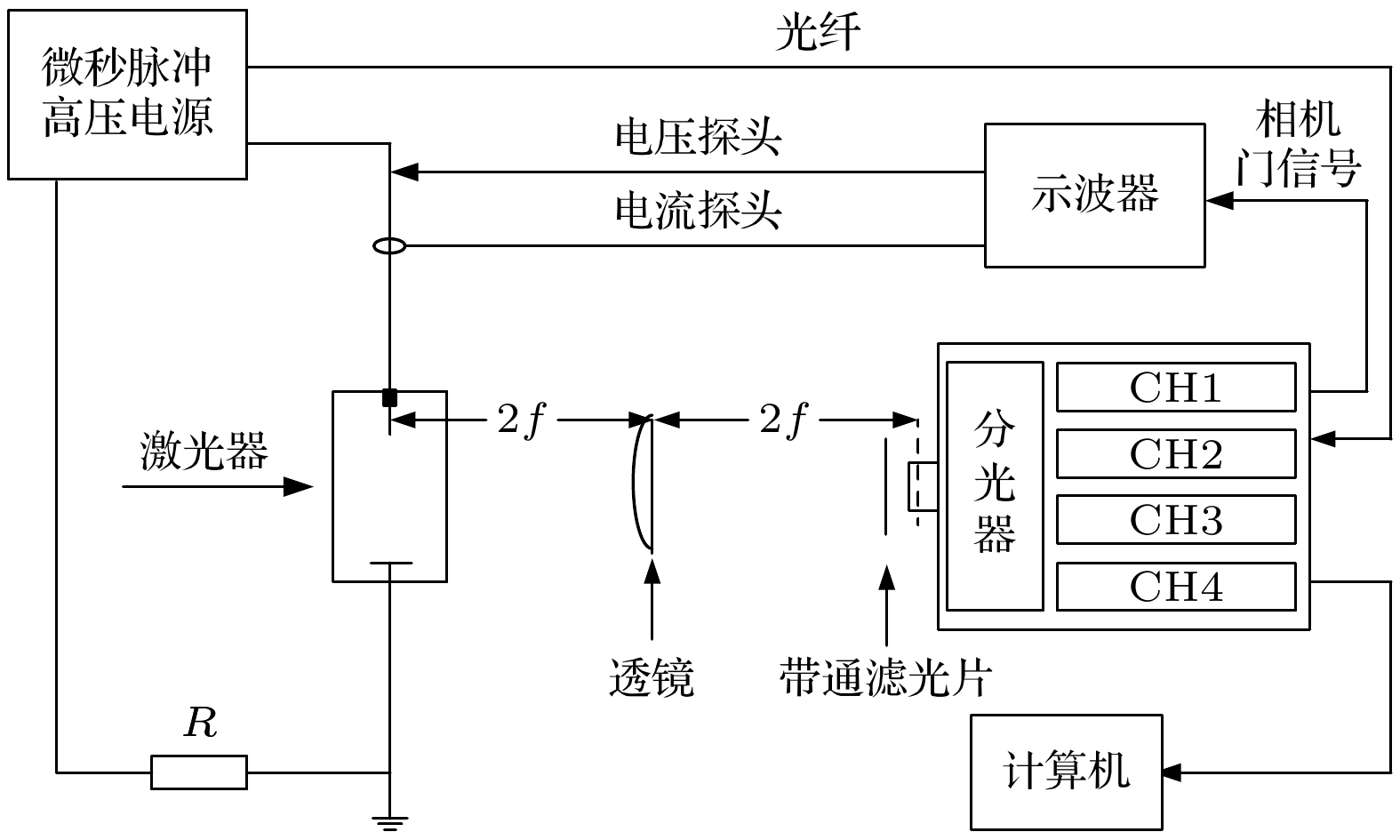
 下载:
下载:
